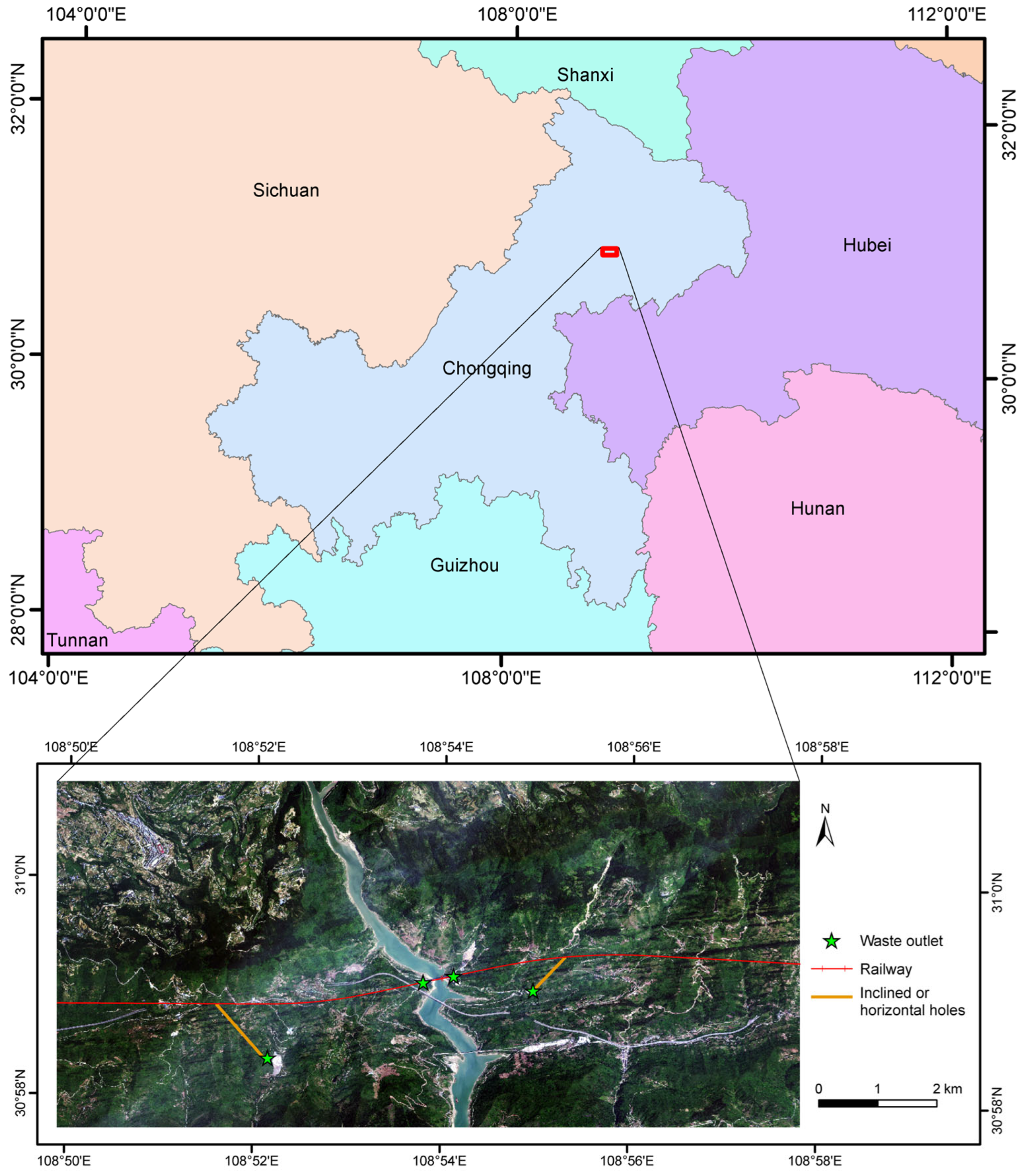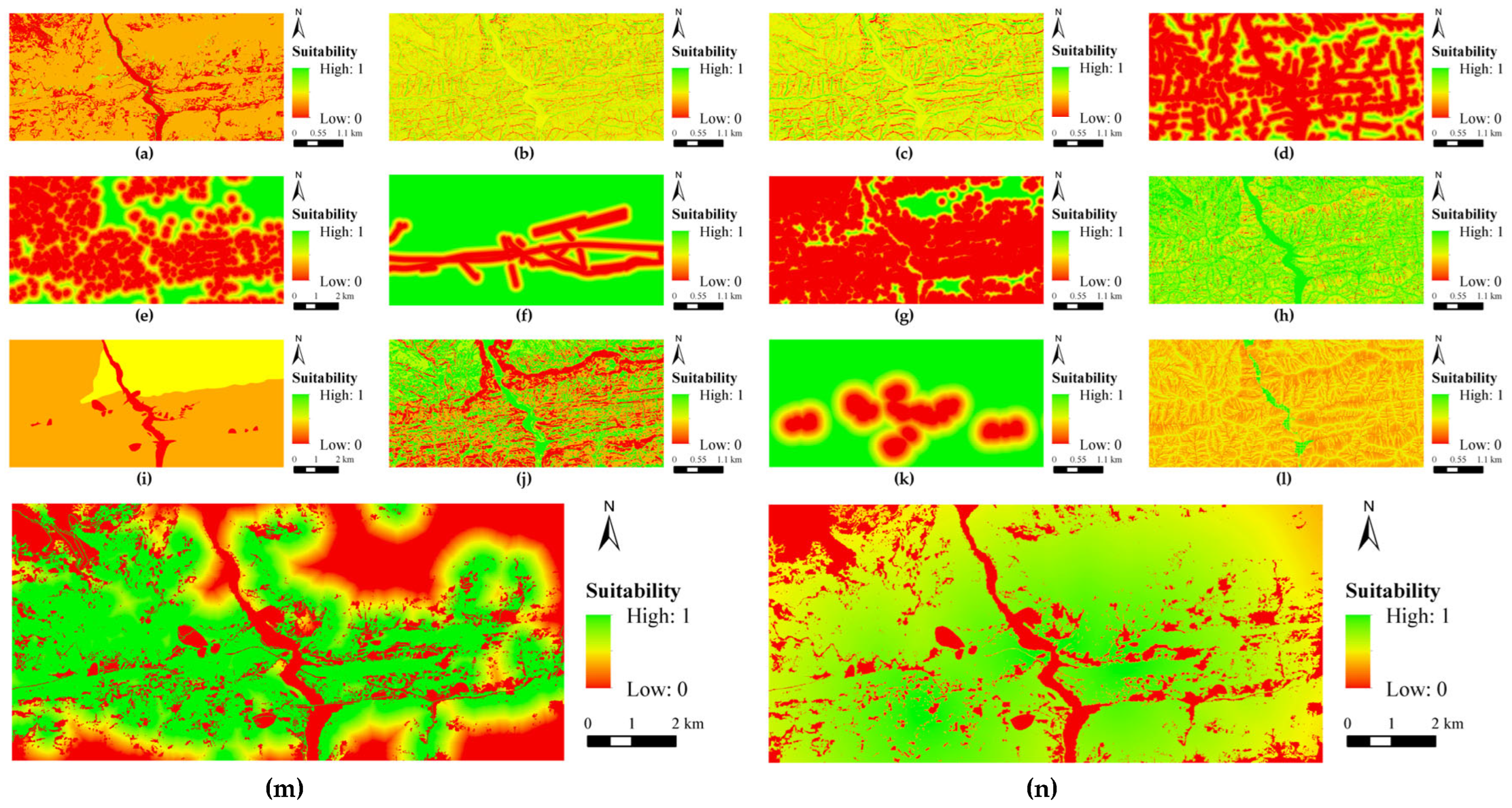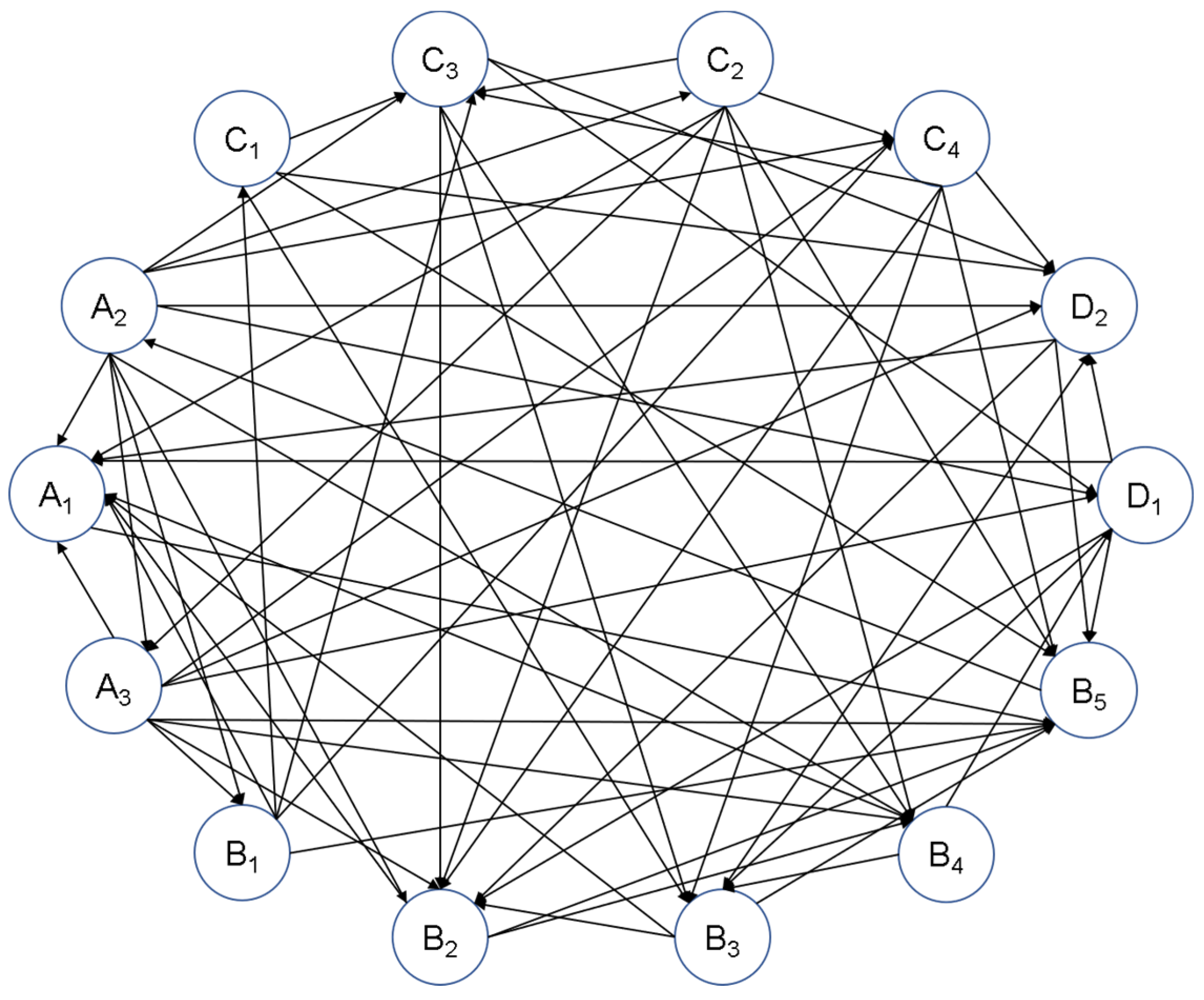Suitability of Site Selection for Mountain Railway Engineering Spoil Disposal Areas from a Multi-Scenario Perspective
Abstract
:1. Introduction
2. Overview of the Research Area
3. Materials and Methodology
3.1. The Fundamental Data and Its Processing
3.2. The Suitability Index System for Site Selection of Abandoned Dreg Site
3.3. Research Methods
3.3.1. Principal Component Analysis Method
3.3.2. Complex Network Theory and the CRITIC Method
- Complex network theory
- 2.
- CRITIC Method
3.3.3. Ordered Weighted Average Method
4. Results and Analysis
4.1. Scenario Simulation of the Site Selection of the Abandoned Dreg Site
4.2. Analysis of the Suitability for the Site Selection of the Abandoned Dreg Site
4.3. Post-Processing Analysis
5. Discussion
6. Conclusions
Author Contributions
Funding
Data Availability Statement
Conflicts of Interest
References
- Zhang, S.; Han, L. Research on Cause Analysis and Prevention Countermeasures of Abandoned Dreg Field Change of Railway Construction Projects. Railw. Stand. Des. 2023, 67, 175–179. [Google Scholar]
- Xiao, W.; Tian, W. Risk Evaluation of Landfills along Highway Based on Material Point Method and Limit Equilibrium Method. J. Catastrophol. 2021, 36, 37–41+59. [Google Scholar]
- Yin, Y.; Li, B.; Wang, W.; Zhan, L.; Xue, Q.; Gao, Y.; Zhang, N.; Chen, H.; Liu, T.; Li, A. Mechanism of the December 2015 Catastrophic Landslide at the Shenzhen Landfill and Controlling Geotechnical Risks of Urbanization. Engineering 2016, 2, 230–249. [Google Scholar] [CrossRef]
- Tian, M.; Zou, Y.; Xiao, A.; Gu, M.; Yin, X. Statistical classification features of particle composition and angle of repose of mountainous highway earth-rock mixed waste slag and its application. Rock Soil Mech. 2022, 43, 469–476. [Google Scholar]
- Jiang, J.; Pan, J.; Cheng, Z.; Xu, H.; Tan, F. Experimental study on mechanical properties of loose spoil considering vertical distribution factor. Chin. J. Rock Mech. Eng. 2022, 41, 631–639. [Google Scholar]
- Li, Y.; Hou, X. Risk Diagnosis and Prediction of Mega-Project Waste Dump Based on Fault Tree and Bayesian Network Integration. J. Syst. Manag. 2022, 31, 861–874. [Google Scholar]
- Wu, Y.; Ruan, B.; Zhang, C.; Zhang, P. Site Selection and Design Method of Waste Dump of Expressway in Southwest Mountainous Area. Highway 2022, 67, 67–74. [Google Scholar]
- Lin, T.; Sun, Z. Rationality of Soil and Water Conservation of Spoil Ground. Soil Water Conserv. China 2022, 2, 47–52. [Google Scholar]
- Huo, P.; Cao, L.; Tian, Y. Application and comparison of AHP and fuzzy evaluation method in landfill siting. Environ. Eng. 2015, 33, 131–135. [Google Scholar]
- Kapilan, S.; Elangovan, K. Potential landfill site selection for solid waste disposal using GIS and multi-criteria decision analysis (MCDA). J. Cent. South Univ. 2018, 25, 570–585. [Google Scholar] [CrossRef]
- Huang, J.; Fu, Z.; Luo, Z.; Liu, X.; Yang, D. Study on suitability zoning for the site selection of landfill in Wuhan City. Environ. Eng. 2015, 33, 105–108+54. [Google Scholar]
- Liu, Y.; Kong, Q.; Esther, W.B. Public preferences for health care facilities in rural China: A discrete choice experiment. Soc. Sci. Med. 2019, 237, 112396. [Google Scholar] [CrossRef] [PubMed]
- Stubager, R. Preference-shaping: An Empirical Test. Political Stud. 2003, 51, 241–261. [Google Scholar] [CrossRef]
- GB 51018-2014; Ministry of Housing and Urban-Rural Development of the PRC, General Administration of Quality Supervision, Inspection and Quarantine of the People’s Republic of China. Code for Design of Soil and Water Conservation Engineering. China Planning Press: Beijing, China, 2014. (In Chinese)
- Karimzadeh, S.; Miyajima, M.; Kamel, B.; Pessina, V. A fast topographic characterization of seismic station locations in Iran through integrated use of digital elevation models and GIS. J. Seismol. 2015, 19, 949–967. [Google Scholar] [CrossRef]
- Khan, M.M.; Vaezi, M.; Kumar, A. Optimal siting of solid waste-to-value-added facilities through a GIS-based assessment. Sci. Total Environ. 2018, 610–611, 1065–1075. [Google Scholar] [CrossRef] [PubMed]
- Sumathi, V.R.; Natesan, U.; Sarkar, C. GIS-based approach for optimized siting of municipal solid waste landfill. Waste Manag. 2008, 28, 2146–2160. [Google Scholar] [CrossRef] [PubMed]
- Wu, Z.; Li, G.; Chen, D.; He, Q.; Zhu, S. Optimal distribution of small-town domestic garbage landfills. Chin. J. Environ. Eng. 2012, 6, 3263–3269. [Google Scholar]
- Perovic, V.; Cakmak, D.; Srbinovic, O.S.; Pavlovich, P.; Simic, S.B.; Matic, M.; Pavlovic, D.; Jaramaz, D.; Mitrovic, M.; Pavlovic, P. A conceptual modelling framework for assessment multiple soil degradation: A case study in the region of Sumadija and Western Serbia. Ecol. Indic. 2023, 148, 110096. [Google Scholar] [CrossRef]
- Zhang, W.; Xie, T.; Liu, B. Rainfall Erosivity Estimation Using Daily Rainfall Amounts. Sci. Geogr. Sin. 2002, 6, 705–711. [Google Scholar]
- Wang, Z.; Ye, L.; Jiang, J.; Fan, Y.; Zhang, X. Review of application of EPIC crop growth model. Ecol. Model. 2022, 467, 109952. [Google Scholar] [CrossRef]
- Liu, B.; Nearing, M.; Shi, P.; Jia, Z. Slope length effects on soil loss for steep slopes. Soil Sci. Soc. Am. J. 2000, 64, 1759–1763. [Google Scholar] [CrossRef]
- Bagarello, V.; Ferro, V.; Pampalone, V. A comprehensive analysis of Universal Soil Loss Equation-based models at the Sparacia experimental area. Hydrol. Process. 2020, 34, 1545–1557. [Google Scholar] [CrossRef]
- Guo, F.; Liu, X.; Mamat, Z.; Zhang, W.; Xing, L.; Wang, R.; Luo, X.; Wang, C.; Zhao, H. Spatiotemporal variations and influencing factors of soil conservationservice based on ln VEST model: A case study of Miyun Reservoir upstream basin of Zhangcheng area in Hebei. Prog. Geophys. 2022, 9, 17. [Google Scholar]
- SL190-2007; Ministry of Water Resources of the PRC. Standards for Classification and Gradation of Soil Erosion. China Water & Power Press: Beijing, China, 2015. (In Chinese)
- Zhang, L.; Li, H.; Gu, C.; Pan, H.; Fu, P. Geological hazard susceptibility assessment based on weighted informationvalue in Yunyang County (The Three Gorges Reservoir Area), Chongqing. Miner. Explor. 2020, 11, 2809–2815. [Google Scholar]
- Li, G.; Tie, Y. Comparative Study on Modeling Methods of Comprehensive Geological Hazard Susceptibility Based on Information Mode. J. Catastrophol. 2023, 38, 212–221. [Google Scholar]
- Mhiret, D.A.; Dagnew, D.C.; Assefa, T.T.; Tilahun, S.A.; Zaitchik, B.F.; Steenhuis, T.S. Erosion hotspot identification in the sub-humid Ethiopian highlands. Ecohydrol. Hydrobiol. 2019, 19, 146–154. [Google Scholar] [CrossRef]
- Kamdar, I.; Ali, S.; Bennui, A.; Techato, K.; Jutidamrongphan, W. Municipal solid waste landfill siting using an integrated GIS-AHP approach: A case study from Songkhla, Thailand. Resour. Conserv. Recycl. 2019, 149, 220–235. [Google Scholar] [CrossRef]
- Chen, S.; Yu, L.; Zhang, C.; Wu, Y.; Li, T. Environmental impact assessment of multi-source solid waste based on a life cycle assessment, principal component analysis, and random forest algorithm. J. Environ. Manag. 2023, 339, 117942. [Google Scholar] [CrossRef] [PubMed]
- Han, Z.; Wang, Y.; Cao, J. Impact of contact heterogeneity on initial growth behavior of an epidemic: Complex network-based approach. Appl. Math. Comput. 2023, 451, 128021. [Google Scholar] [CrossRef]
- Yang, X.; Hu, D.; Zhan, X.; Zhang, Z. A method for identifying and ranking influential spreading nodes in complex networks based on neighborhood core diversity centrality. Chin. High Technol. Lett. 2016, 26, 129–138. [Google Scholar] [CrossRef]
- Kitsak, M.; Gallos, L.K.; Havlin, S.; Liljeros, F.; Muchnik, L.; Stanley, H.E.; Makse, H.A. Identification of influential spreaders in complex networks. Nat. Phys. 2010, 6, 888–893. [Google Scholar] [CrossRef]
- Weng, X.; Yang, S. Private-Sector Partner Selection for Public-Private Partnership Projects Based on Improved CRITIC-EMW Weight and GRA -VIKOR Method. Discret. Dyn. Nat. Soc. 2022, 2022, 9374449. [Google Scholar] [CrossRef]
- Zheng, T.; Chen, H.; Yang, X. Entropy and probability based Fuzzy Induced Ordered Weighted Averaging operator. J. Intell. Fuzzy Syst. 2023, 44, 4949–4962. [Google Scholar] [CrossRef]






| Data | Source |
|---|---|
| DEM data | https://www.tianditu.gov.cn/ (accessed on 23 March 2023) |
| Land-use-type data | https://doi.org/10.1016/j.scib.2019.03.002 (accessed on 25 March 2023) |
| NDVI data | https://www.resdc.cn (accessed on 28 March 2023) |
| Rainfall data | https://www.ncdc.noaa.gov (accessed on 28 March 2023) |
| Water system data, residential land data, public facilities data, road network data, stratum lithology data, adverse geology data, rainfall data, soil physical and chemical properties data, adverse geology data, and soil physical and chemical properties data | CAD engineering drawings provided by the project engineering party |
| Criteria Layer | Index Layer | Criteria Guideline | Normalized Assignment Method | Attribute * |
|---|---|---|---|---|
| Construction cost | Land use type | Refs. [1,7,8,14] | Water, cropland, impervious surface, 0; forest, 0.3; grassland, shrubland, 0.7; bareland, 1 | + |
| Terrain curvature | Refs. [1,7,8,14] | Normalize | − | |
| TPI | Refs. [14,15] | Normalize | + | |
| Society and ecology | Distance to water system | Refs. [9,11,14,16,17] | <100, 0; 100–500, normalize; >500, 1 | + |
| Distance to residential land | Refs. [9,11,14,17] | <100, 0; 100–500, normalize; >500, 1 | + | |
| Distance to public facilities | Refs. [9,11,14,16] | <100, 0; 100–500, normalize; >500, 1 | + | |
| Distance to cropland | Refs. [14,18] | <100, 0; 100–500, normalize; >500, 1 | + | |
| Soil erosion intensity | Refs. [14,19,20,21,22,23,24,25] | Slight erosion, 1; light erosion, 0.8; moderate erosion, 0.6; strong erosion, 0.4; very strong erosion 0.2; severe erosion, 0 | − | |
| Natural security | Lithological type | Refs. [9,11,14,26,27] | Loose soil, 0; soft rock, 0.3; softer rock, 0.5; harder rock, 0.7; hard rock, 1 | + |
| Slope | Refs. [9,11,14] | <5°,1; 5°–15°, 0.7; 15°–25°, 0.5; 25°–35°, 0.3; >35°, 0 | + | |
| Distance to adverse geology | Refs. [11,14,17] | <200, 0; 200–1000, normalize; >1000, 1 | + | |
| SPI | Refs. [14,28,29] | normalize | − | |
| Spatial accessibility | Distance to road | Refs. [9,11,14,16] | <200, 1; 200–1000, normalize; >1000, 0 | − |
| Distance to waste outlet | Refs. [11,14,16] | <200, 1; 200–10,000, normalize; >10,000, 0 | − |
| Criteria Layer | Index Layer | ||||
|---|---|---|---|---|---|
| Construction cost | 0.390 | Land use type | 0.018 | 0.103 | 0.028 |
| Terrain curvature | 0.121 | 0.114 | 0.211 | ||
| TPI | 0.133 | 0.074 | 0.151 | ||
| Society and ecology | 0.329 | Distance to water system | 0.100 | 0.021 | 0.033 |
| Distance to residential land | 0.100 | 0.081 | 0.124 | ||
| Distance to public facilities | 0.088 | 0.062 | 0.083 | ||
| Distance to cropland | 0.072 | 0.075 | 0.082 | ||
| Soil erosion intensity | 0.006 | 0.093 | 0.008 | ||
| Natural security | 0.148 | Lithological type | 0.149 | 0.029 | 0.065 |
| Slope | 0.009 | 0.053 | 0.007 | ||
| Distance to adverse geology | 0.086 | 0.036 | 0.047 | ||
| SPI | 0.036 | 0.052 | 0.029 | ||
| Spatial accessibility | 0.133 | Distance to road | 0.052 | 0.112 | 0.089 |
| Distance to waste outlet | 0.031 | 0.094 | 0.044 |
| Subsystem Indicators | Formulas * |
|---|---|
| Subsystem degree | |
| Subsystem nodes proportion | |
| Subsystem network density | |
| Subsystem network aggregation |
| 1.000 | 0.912 | 0.632 | 0.250 | 0.160 | 0.000 | |
| 0.000 | 0.053 | 0.204 | 0.250 | 0.330 | 0.028 | |
| 0.000 | 0.025 | 0.112 | 0.250 | 0.320 | 0.320 | |
| 0.000 | 0.010 | 0.051 | 0.250 | 0.190 | 0.651 |
| Type | Scenario Description |
|---|---|
| Construction cost type | Establish the concepts of cost reduction and efficiency, priority should be given to selecting concave terrain such as gourd shaped and bowl shaped for the layout of waste disposal areas. and reduce the unnecessary cost consumption arising from the construction process. |
| Social and ecological type | Focusing on the social and ecological benefits brought about by the construction of the project, and adhering to the concept of green and environmental protection, the project design and construction should avoid adverse impacts on the economy and society and the ecological environment. |
| Natural security type | Scientific assessment of the topographic environment and geological conditions of the project area is carried out at the stage of investigation and design of the project, to reduce the potential risks of geologic hazards during the construction and operation phases of the project. |
| Spatial accessibility type | Ensure the spatial accessibility and traffic convenience of the geographic location of the disposal sites to reduce the transportation cost of the slag and soil disposal. |
| Comprehensive balance type | Consider the impact of all factors in an integrated and comprehensive manner. |
| Suitability Region | Construction Cost Type | Social and Ecological Type | Natural Security Type | Spatial Accessibility Type | Comprehensive Balance Type |
|---|---|---|---|---|---|
| Unsuitable region | 19.27% | 19.27% | 19.47% | 19.61% | 19.27% |
| Low suitable region | 18.66% | 19.46% | 15.09% | 5.26% | 14.87% |
| Suitable region | 30.00% | 30.87% | 21.05% | 21.26% | 22.45% |
| High suitable region | 19.94% | 18.08% | 29.98% | 26.73% | 29.98% |
| Most suitable region | 12.13% | 12.33% | 14.41% | 27.14% | 13.43% |
Disclaimer/Publisher’s Note: The statements, opinions and data contained in all publications are solely those of the individual author(s) and contributor(s) and not of MDPI and/or the editor(s). MDPI and/or the editor(s) disclaim responsibility for any injury to people or property resulting from any ideas, methods, instructions or products referred to in the content. |
© 2024 by the authors. Licensee MDPI, Basel, Switzerland. This article is an open access article distributed under the terms and conditions of the Creative Commons Attribution (CC BY) license (https://creativecommons.org/licenses/by/4.0/).
Share and Cite
Li, Y.; Zeng, C.; Han, Z.; Wang, W.; Huang, J. Suitability of Site Selection for Mountain Railway Engineering Spoil Disposal Areas from a Multi-Scenario Perspective. Buildings 2024, 14, 1184. https://doi.org/10.3390/buildings14041184
Li Y, Zeng C, Han Z, Wang W, Huang J. Suitability of Site Selection for Mountain Railway Engineering Spoil Disposal Areas from a Multi-Scenario Perspective. Buildings. 2024; 14(4):1184. https://doi.org/10.3390/buildings14041184
Chicago/Turabian StyleLi, Yange, Cheng Zeng, Zheng Han, Weidong Wang, and Jianling Huang. 2024. "Suitability of Site Selection for Mountain Railway Engineering Spoil Disposal Areas from a Multi-Scenario Perspective" Buildings 14, no. 4: 1184. https://doi.org/10.3390/buildings14041184





